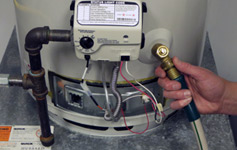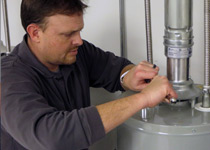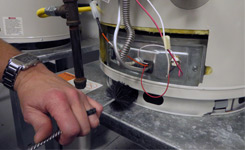Water Heater Maintenance Tips
You can extend the life of your commercial and residential water heaters and prevent leaks with a few routine maintenance tasks. Leaking water heaters are often caused by high water pressure or thermal expansion. You can measure the water pressure on your water heater with a gauge and keep it under control by installing a pressure reducing valve or a thermal expansion tank when required.



Routine Maintenance for Water Heaters
These simple maintenance tasks will help keep your water heaters working safely and efficiently. Always disconnect the power before you perform any maintenance on water heaters.
-
Clear Away Flammable Materials
Regularly check around the water heater for flammable material like cleaning chemicals, paint, gasoline, and other combustibles such as paper or cleaning rags. Never store any flammable material near the water heater.
-
Check for Leaks
Inspect monthly around the water heater for any signs of leaks. Replace or repair any damaged valves.
-
Adjust the Temperature
The water temperature on your water heater should be kept at 120 degrees Fahrenheit to prevent scalding and save energy. For every 10 degrees the temperature is lowered, you can expect to save up to 5% in energy costs.
-
Drain and Flush the Water Heater Tank
Flushing your water heater at least once a year keeps sediment from building up and extends the life of your unit. For hard water conditions you may want to flush the water heater tank more often than once a year. To drain your water heater tank, connect a garden hose to the drain valve and drain a few gallons of water until the water runs clear. Or you can use a transfer pump and a hot water hose to reduce the draining time and to boost the pressure when flushing the water heater tank.
-
Inspect the T&P Valve
Once a year test the temperature and pressure (T&P) release valve to make sure it operates properly. Mineral and rust buildup can cause it to stop working. Always check the label on the pressure release valve to find instructions on best testing practices.
-
Inspect the Anode Rod
The anode rod inside the water heater helps protect the tank from leaks and should be checked from time to time and replaced if needed. An anode rod needs to be replaced when only the bare support wire remains.
-
Inspect FVIR System
All gas residential water heaters manufactured after 2003 will have a FVIR (Flammable Vapor Ignition Resistant) System. These units have a sealed combustion chamber with a specially designed "Flame Arrestor" plate on the underside of the water heater. In order for the water heater to have enough primary air drawn into the combustion chamber to sustain combustion, the arrestor plate must be kept clean. Under normal conditions, the action of the burner igniting will remove dust and lint from the arrestor plate. However, if an accumulation of dust, lint, and other debris occurs, clean as required.
-
Clean a Blocked Arrestor Plate
You can us a soft plastic bristle brush to clean the water heater's flame arrestor to remove any debris, lint, or dust. Use a vacuum to clean the brush and repeat this process until the brush comes clean.
Water Heater Insulation
Newer water heaters typically use a new higher "R-Value" foam-type insulation and do not require additional insulation blankets. If your water heater is older, and is warm to the touch, adding an insulation blanket or pipe insulation could be a good way to save energy. If you opt to use an insulation blanket, it is important that you never cover any air openings, warning labels, or safety devices. In some cases replacing the water heater with a newer model may be a better and safer option.
Find more water heater frequently asked questions on our water heater troubleshooting tips page.
More Water Heater Maintenance Tips
This short video explains the water heater maintenance you need to perform regularly to help prevent problems and extend the life of your water heater.
